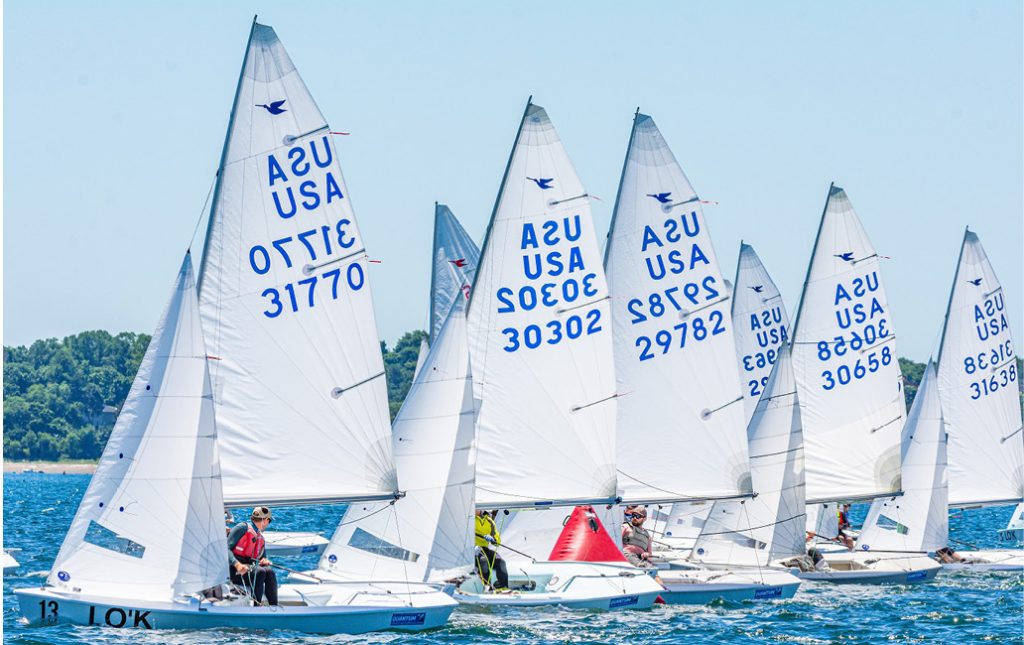When you’re trying to catch other boats on a windward leg, the good news is that the fleet usually spreads out a lot on beats. If the wind changes very much in direction or velocity, this separation creates good passing opportunities.
But the bad news is that the boats you’re trying to catch are all between you and the wind. This means you must constantly dodge wind shadows, especially when you are sailing toward the ‘favored’ side.
As a result, beats often allow the “rich to get richer.” The leaders have clearer air, go faster and keep getting farther ahead. Here are some strategies that will help you catch up to, or at least stay even with, the boats in front of you:
• Stop the bleeding. One of the keys to a good comeback is taking action as soon as you recognize that things are going downhill. This means you might have to bail out of a bad start well before the starting gun, or “bite the bullet” when you recognize you’re on the wrong side of a persistent shift. The critical thing is to stop the bleeding early. The longer you wait to change things, the farther behind you will get.
• Make a smart first tack. If you have a bad start, your most important decision may involve when to make your first tack off the line. Sometimes you will have one opening right away, so you have to be ready to grab it. Other situations require more patience. For example, if you would have to duck 10 boats on port tack, it might be better to sail a few more boatlengths and see if one or two boats clear out. Then maybe you can cross them all.

One good thing about being near a lot of other boats is that you get many chances to check your speed. © Bruce Durkee
• Gain distance early. In most comeback attempts, your priority in the early part of the race should be to gain as much (or lose as little) distance as possible on the rest of the fleet. Try to do the right things strategically so you get back in touch with the leaders. As the race goes on, focus more on the tactics of passing boats in front of you.
• Keep your eye on the prize. Remember that your goal is to get to the finish as soon as possible, so be careful of things that might slow you down along the way:
– Don’t mess with other boats. To improve your position, you must pass other boats, but try not to get tangled up with them. Every time you make a tactical move relative to another boat you lose to the rest of the fleet, so minimize the time and distance you waste.
– Don’t tack too much. In most boats you lose at least a boatlength every time you tack. So, one of the worst things you can do is be a sailing ping-pong ball. It’s usually better to tack than to sail in bad air, but if you find yourself tacking too much, work harder at getting lanes of clear air.
– Don’t sail in bad air. In light to medium wind, a boat sailing in bad air might be going only 75% of the speed of a boat in clear air. That means you could be losing one boatlength or more every ten seconds! This is way too costly unless you have a very good reason for remaining in that position.
• Anticipate changes. It’s always important to anticipate what will happen with the wind, but when you’re back in the fleet, you have to think about what the other boats will do too. Keep an eye on the boats ahead of you and use smart tactical moves to stay in control of your race. ■
A resident of Easton, CT, Dellenbaugh was tactician and starting helmsman for America3’s successful defense of the America’s Cup in 1992. He’s a Lightning World Champion, two-time Congressional Cup winner, seven-time Thistle National Champion, two-time winner of the Canada’s Cup, three-time Prince of Wales U.S. Match Racing Champion, and a winner of the U.S. Team Racing Championships for the Hinman Trophy.




